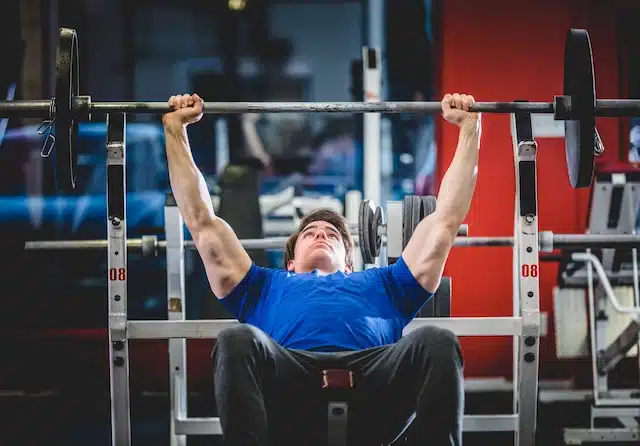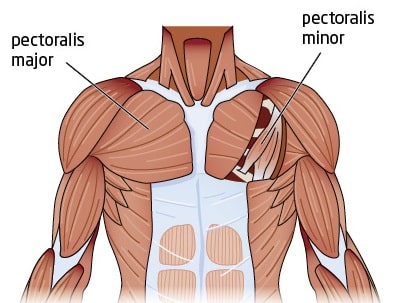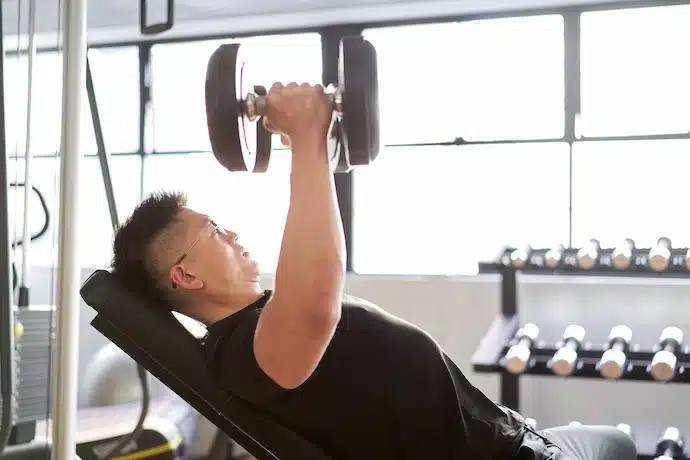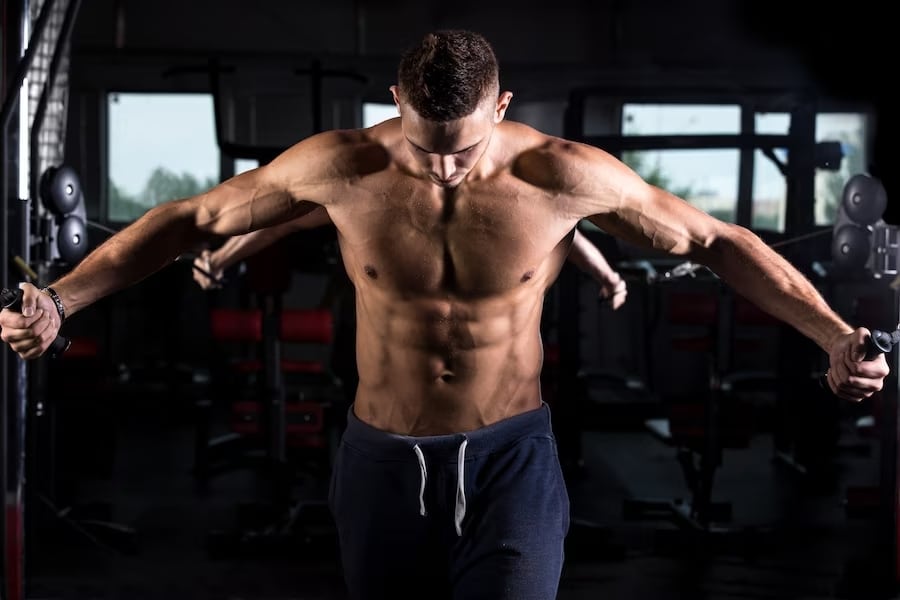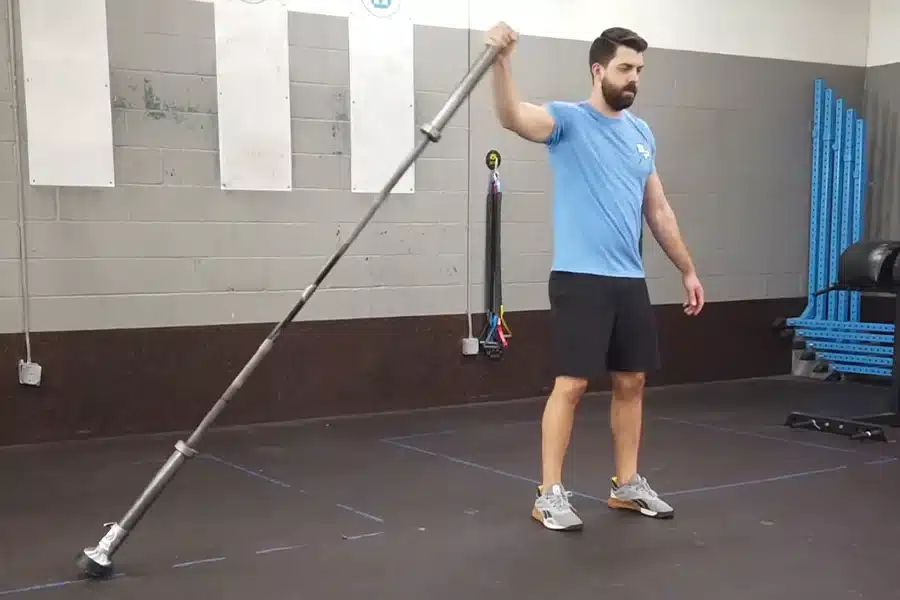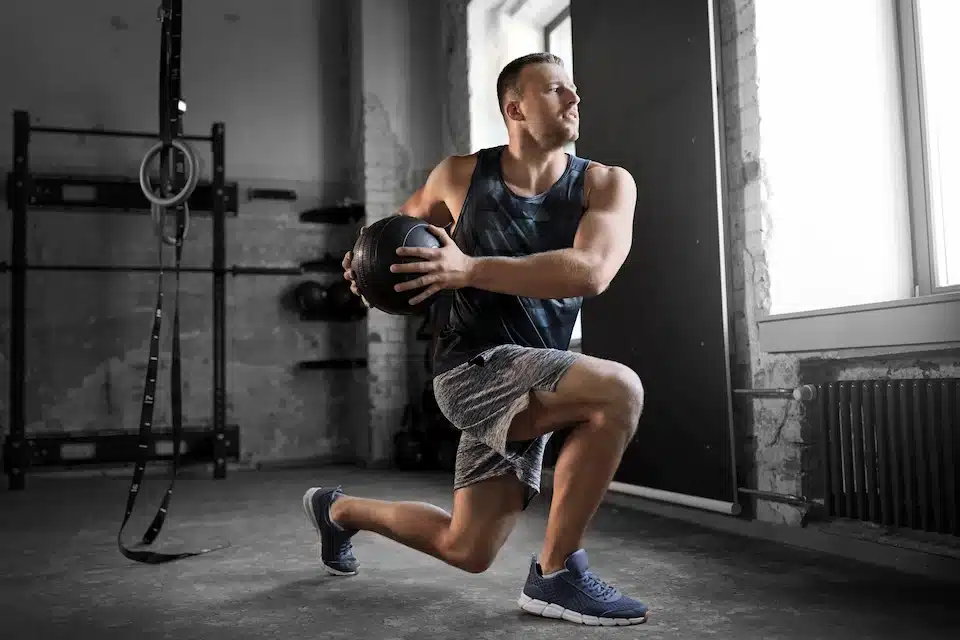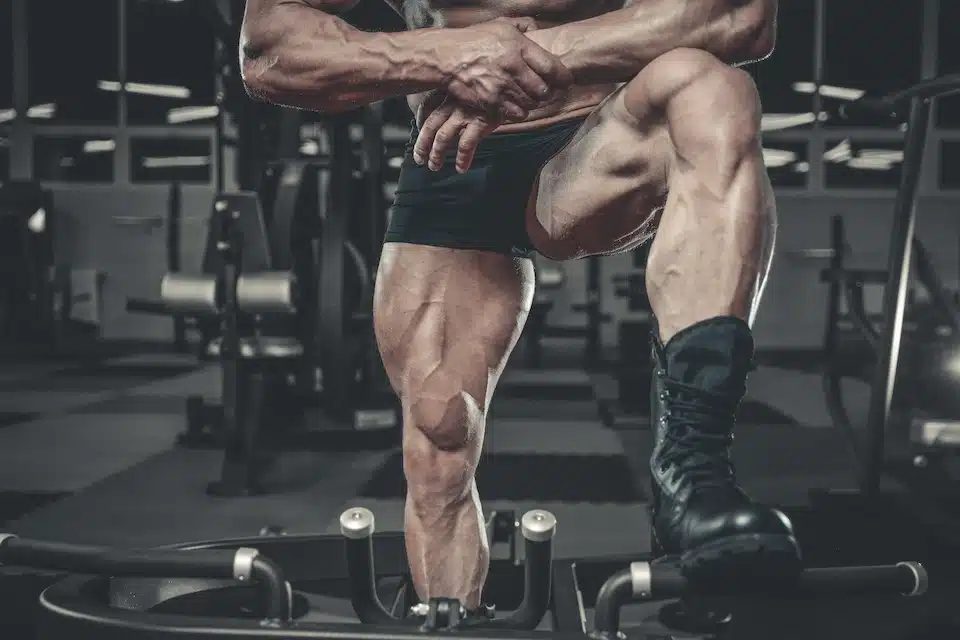Are your upper chest muscles not developing as you hoped? The clavicular part of the pectoralis major is essential for a strong, balanced chest. This guide covers the best exercises for upper chest to help you build powerful pecs.
Start your chest transformation today.
- Why Focus on the Upper Chest?
- Key Muscles of the Upper Chest
- Best Exercises for Building Upper Chest Strength
- Advanced Upper Chest Exercises
- Upper Chest Workouts
- Upper Chest Exercise Variations and Modifications
- Training Tips for Upper Chest Development
- Stretching and Recovery for Upper Chest
- Frequently Asked Questions About Upper Chest Training
- Conclusion
Key Takeaways
- Target Key Muscles: Focus on the pectoralis major and minor to build a strong, defined upper chest.
- Top Exercises: Use incline bench presses, incline dumbbell presses, and low-to-high cable flyes for best results.
- Optimal Angles: Set benches at a 30-degree incline to maximize upper chest activation and reduce shoulder strain.
- Workout Frequency: Train your upper chest 1-2 times each week with 3-4 sets of 8-12 reps per exercise.
- Proper Form and Recovery: Maintain good form during exercises and allow at least 48 hours for muscles to recover.
Why Focus on the Upper Chest?
Focusing on the upper chest builds stronger pectoral muscles and makes your chest look more defined. It also helps improve your strength and keeps your posture steady.
Improved Aesthetics
Building the upper chest improves your physique. Strong pec muscles lift the chest and make the collarbone more defined. Incline bench presses and dumbbell presses target the pectoralis major’s clavicular head.
Push-ups and chest presses help muscle growth. This focus creates a balanced chest with an attractive upper cut. Well-developed upper chest muscles enhance the overall appearance of your chest area.
Enhanced Strength and Power
Strengthening the upper chest boosts your pressing power. Exercises like incline bench press and dumbbell fly target the pectoralis major muscle. This growth helps in strength training and enhances performance in sports.
Strong upper chest muscles support the triceps and front delts during push ups and other movements. Progressive overload in these exercises builds muscle fibers and increases power.
A strong upper chest is key to a powerful physique and better athletic performance.
Next, let’s explore the key muscles of the upper chest.
Better Posture and Shoulder Stability
Strengthening the upper chest muscles improves your posture by pulling the shoulders back. This reduces the chances of slouching and the development of “man boobs.” Exercises like incline presses target the pectoralis major and pec minor, helping align the breastbone and collarbone properly.
Strong upper chest muscles also support shoulder stability. When your upper chest is strong, it helps keep the shoulders steady during movements, reducing the risk of injuries. Using free weights or dumbbell bench presses can enhance muscle activation in the upper arms and shoulders, promoting better balance and control.
Next, let’s explore the key muscles of the upper chest.
Key Muscles of the Upper Chest
The upper chest has two main muscles: the pectoralis major and the pectoralis minor. Building these muscles helps create a strong and well-defined chest.
Pectoralis Major
The pectoralis major is a large chest muscle essential for upper chest workouts. The clavicular head of the pec major helps lift your arms and stabilize your shoulders. Exercises like incline bench pressing target this part effectively.
Using different bench angles can change how much the pectoralis major works, helping you build strength and size.
Incline flyes and push-ups with feet elevated also activate the pec major. Proper form ensures maximum muscle engagement. Focusing on the pectoralis major improves your upper chest’s appearance and power.
Including these exercises in your routine supports balanced muscle development and overall chest strength.
Pectoralis Minor
Pectoralis Minor helps stabilize the shoulder blades. This support improves press-up and pressing up exercises. During resistance training, a strong pectoralis minor enhances your chest press performance.
It also plays a role in bodyweight exercises like pushups, allowing for better form and efficiency.
Strengthening all chest muscles, including the pectoralis minor, leads to balanced and powerful upper body development.
Best Exercises for Building Upper Chest Strength
Strengthening your upper chest shapes your pecs and boosts your strength. Try exercises like chest presses and flys using dumbbells or cables to build powerful muscles.
Incline Bench Press
The incline bench press effectively targets the upper chest. Setting the bench at an angle engages the pectoralis major and minor muscles more. Lauver et al. (2016) found that different bench angles can change muscle activation levels.
Use a barbell or dumbbells for this chest press to build strength and size. Keep your elbows slightly bent to reduce strain. Press the weight up smoothly, focusing on your upper chest.
This exercise also involves the triceps and shoulders, enhancing overall upper-body strength.
Incline Dumbbell Press with Semi-Pronated Grip
Incline dumbbell press with a semi-pronated grip builds the upper chest well. Free weights enable better arm adduction, enhancing chest contraction. This chest press targets the clavicle area of the pectoralis major.
Using this grip also involves the anterior deltoids and triceps. It improves upper chest strength and muscle recovery. Incorporate this resistance exercise into your routine for powerful pecs.
Consistency in your incline dumbbell press will sculpt your upper chest.
Low-to-High Cable or Band Flye
Low-to-high cable or band flye targets the upper chest effectively. This exercise uses arm adduction to activate the pectoralis major and minor. Stand with cables or bands set low.
Lean back slightly to increase tension. Bring your hands upward in a sweeping motion toward your collar bone. Keep a slight bend in your elbows to protect your joints. Focus on squeezing your upper chest at the top of each rep.
This movement enhances upper chest activation and builds powerful pecs.
Using low-to-high flyes improves strength and muscle definition. Incorporate this exercise into your chest press or incline fly routines. Adjust the cables or bands for the best angle.
Consistent training with low-to-high flyes helps develop a strong, sculpted upper chest. Combine with other isolation exercises for balanced muscle growth and better shoulder stability.
Reverse Grip Dumbbell Press
After completing low-to-high cable or band flyes, the reverse grip dumbbell press is an excellent choice. This exercise targets the upper chest effectively by using a supinated (underhand) grip.
Holding the dumbbells with palms facing up increases activation of the pectoralis major. Adjusting your grip can change how your muscles work, enhancing strength and power. Use free weights to engage more muscles and improve stability.
Keep your elbows close to your body to focus on the upper chest and minimize shoulder involvement. Incorporate the reverse grip dumbbell press into your routine to build a stronger, more defined upper chest.
Advanced Upper Chest Exercises
Advanced exercises target your upper chest more intensely. Using specialized workout tools, you can build stronger and more defined pecs.
Converging Incline Machine Press
The Converging Incline Machine Press targets the upper chest effectively. It uses a machine that angles the press upward, activating the upper chest more than flat presses. This unique angle helps improve your chest press technique and build stronger pectoralis major muscles.
A consistent pressing motion ensures each rep works your muscles fully. The machine guides your movement, making each press safe and effective. Incorporate the converging incline machine press into your routine to enhance upper chest strength and size.
Next, explore the Swiss-Bar Incline Press.
Swiss-Bar Incline Press
The Swiss-Bar Incline Press targets the upper chest with a neutral grip. This grip lessens shoulder strain, making it easier to push up heavy weights. Using the Swiss-bar helps engage the pectoralis major and minor effectively.
Stability comes from the lats and rear delt muscles, ensuring proper form. You focus on the upper chest without overusing the shoulders. Advanced weightlifting techniques like the Swiss-Bar Incline Press build powerful pecs safely.
Next, explore the Incline Dumbbell Flye for further upper chest development.
Incline Dumbbell Flye
Incline Dumbbell Flye targets the upper chest effectively. Using free-weights, you can achieve a wide range of motion. This movement activates more muscle fibers in the pectoralis major.
Set an incline bench to about 30 degrees. Hold a dumbbell in each hand with a semi-pronated grip. Slowly lower the weights with a slight internal rotation. Push the dumbbells up, squeezing the upper chest at the top.
This exercise helps strengthen the clavicles and ribcage. It supports hypertrophy training and enhances muscle definition for a powerful pec.
Incline Dumbbell Around The World
The dumbbell around the world exercise effectively targets the upper chest through dynamic movements. Rotating the dumbbells in a circular pattern engages the pectoralis major comprehensively.
Combining chest presses and flys ensures thorough electromyographic activity across the upper chest muscles. This exercise enhances strength and promotes muscle growth in the upper-arm bone area.
Incorporating this movement into your workout can improve upper chest aesthetics and strength. Adjusting grip variations and pressing angles optimizes chest dip engagement while minimizing shoulder involvement.
The dumbbell around the world also helps stabilize the pelvis and lower back, supporting overall chest development.
Upper Chest Workouts
Explore effective upper chest workouts using weights and incline benches to build strong and defined pecs.
Sample Upper-Chest Workout A
Start with the Incline Bench Press. Complete four sets of eight to twelve reps. This exercise builds powerful pecs by targeting the pectoralis major. Next, move to Dumbbell Chest Flyes.
Perform three sets of twelve to fifteen reps. These flyes sculpt the upper chest and enhance chest press strength. Use a semi-pronated grip to maximize results. Keep your movements steady to focus on the upper chest muscles.
Sample Upper-Chest Workout B
Start with the incline dumbbell press. Do 3 sets of 10-12 reps. This move builds the pectoralis major. Next, perform low cable crossovers. Complete 3 sets of 12-15 reps. Focus on squeezing your upper chest at the top.
Move to incline flys using a Smith machine. Do 3 sets of 10-12 reps. This exercise shapes your chest muscles. Finish with the dumbbell pullover. Do 3 sets of 10-12 reps. It targets the upper chest and lats.
Keep your form steady to avoid injury. Choose weights that match your strength level.
Sample Upper-Chest Workout C
Start with the Guillotine press. Perform 4 sets of 8-12 reps. This exercise targets the upper chest and helps build strong pecs. Next, do incline push-ups. Complete 3 sets to failure.
Elevating your feet increases the focus on the upper chest. Incorporate chest press movements to enhance strength and bodybuilding results. Use a dip belt if needed to add resistance.
This workout boosts upper arm bone strength and supports better posture. Move on to the next workout example to continue your upper chest development.
Sample Upper-Chest Workout D
Begin with the Incline Hex Press. Do 3 sets of 10-12 reps. This chest press targets the upper chest and builds strength. Next, perform Dips. Complete 3 sets to failure. Dips push up your body and engage the pectoralis major.
Add pushups with feet elevated to focus on the upper cut. This exercise enhances your chest press and rib strength. Finish the workout with lean back cable presses. This move sculpts powerful pecs and improves muscle definition.
Upper Chest Exercise Variations and Modifications
Explore various ways to target your upper chest with different exercises. Using tools like dumbbells and cables can make your workouts more effective.
Pushup with Feet Elevated
Elevating your feet during pushups shifts the focus to the upper chest. This angle targets the clavicular head of the pectoralis major. Pushups with feet elevated enhance chest press strength and build powerful pecs.
They also engage the shoulders and triceps, boosting overall upper body strength. Incorporate this exercise into your strength and conditioning routine to improve your upper chest and achieve better posture.
Low To High Cable Flys
Low to high cable flys effectively target the upper chest. Set the cables low and move your hands upward in a diagonal path. This motion activates the pectoralis major and minor muscles.
The diagonal movement ensures better muscle engagement. Grip the handles firmly to involve your forearms. Keep your elbows slightly bent to reduce strain on the humerus. Focus on squeezing your chest at the top of the movement for maximum effect.
Incorporating this exercise can enhance your chest press strength and upper cut.
Explore other variations to further sculpt your upper chest. Next, try a pushup with your feet elevated for additional muscle activation.
Landmine Kneeling Squeeze Press
The Landmine Kneeling Squeeze Press is a great exercise for the upper chest. It uses a landmine setup, which helps target the pectoral muscles effectively. Kneeling adds stability and focuses the effort on your chest.
This move combines pressing and squeezing, making your muscles work harder. Landmine rainbows are also good for the upper chest. They help improve muscle activation and build strength.
Using this exercise can enhance your chest press routine and give you powerful pecs.
Dumbbell Pullover
Dumbbell pullover targets the upper chest and lats. Lie on a bench with your feet flat on the ground. Hold a dumbbell with both hands above your chest. Slowly move the weight back over your head, keeping your arms slightly bent.
This stretching movement helps engage your upper chest muscles better. It also works your lats, adding strength to your upper body.
Using dumbbell pullover can improve your chest press performance. The exercise engages the pectoralis major and minor effectively. Including external rotation, you enhance muscle activation.
Consistent practice of this move helps build powerful pecs and contributes to a balanced upper body.
Training Tips for Upper Chest Development
Adjust the bench to an incline to target your upper chest effectively. Change your grip on presses to work different muscle areas.
Optimal Pressing Angles
Choosing the right pressing angle is key for building your upper chest. A 30-degree incline bench press targets the clavicular head of the pectoralis major effectively. This angle maximizes muscle activation, helping you develop stronger and more defined upper pecs.
Using this angle in exercises like the incline dumbbell press can enhance pushing up movements and improve chest press performance.
Different bench angles change how your muscles work. Steeper angles may engage the shoulders more, while a 30-degree incline focuses on the upper chest without overusing the shoulders.
This balance helps prevent injuries and promotes better muscle growth. Incorporate the optimal 30-degree angle into your workouts to achieve powerful and sculpted upper chest muscles.
Grip Variations and Their Effects
Different grip variations can change how your muscles work during exercises. For example, using a reverse grip press helps target the upper chest more effectively. This grip shifts the focus, making your upper pecs work harder.
A semi-pronated grip on the incline dumbbell press also engages the upper chest. By adjusting your grip, you can enhance muscle activation and build stronger, more powerful pecs. These changes make your chest workouts more effective and help sculpt your upper chest.
Sets, Reps, and Load Recommendations
Do 3 to 4 sets for each upper chest exercise. Complete 8 to 12 reps in each set. Choose a weight that makes the last few reps hard to finish. This load helps your muscles grow and get stronger.
Using the right sets and reps is important for effective chest press workouts. Consistent training with proper sets and reps builds powerful pecs and improves your upper chest strength.
Stretching and Recovery for Upper Chest
After your workout, do warm-up stretches to prepare your chest muscles. Cool-down stretches help your upper chest recover and stay flexible.
Dynamic Chest Opener (Warm-up)
A dynamic chest opener warms up the upper chest muscles before exercise. Move your arms in a wide arc. Swing them back and forth. This activates the pectoralis major and minor. It also helps increase blood flow to the area.
Using movements like arm circles or push-up plus can enhance flexibility. A good warm-up reduces the risk of injury. It prepares your upper chest for pressing exercises. Include this routine before your chest press or incline bench press.
Static Chest Stretch (Cool-down)
Finish your upper chest workout with a static chest stretch. Hold your arms out against a wall for 20 seconds on each side. This stretch helps your muscles recover from chest press exercises.
It also improves flexibility, which supports stronger pecs. Including this cool-down enhances muscle recovery and maintains good shoulder stability.
Frequently Asked Questions About Upper Chest Training
This section answers common questions about training the upper chest. Discover effective exercises and techniques to build strong pecs.
How often should I train my upper chest?
Train your upper chest one to two times each week. This schedule gives your pectoral muscles time to grow strong. Include exercises like the chest press and incline bench press in your workouts.
Allow at least 48 hours of rest between sessions. Proper recovery helps prevent injuries and builds muscle effectively. Overworking can lead to strains and slow your progress. Next, we’ll discuss if training your upper chest every day is possible.
Can I train my upper chest every day?
After deciding how often to train your upper chest, you might wonder if daily workouts are possible. Training your upper chest every day is not recommended. Muscles, like the pectoralis major, need time to recover after exercises such as the chest press.
Without proper rest, muscle growth can slow, and the risk of injury increases. Aim to work your upper chest 2-3 times each week to build strength and ensure your muscles stay healthy.
How do I isolate the upper chest without involving the shoulders too much?
To isolate the upper chest and minimize shoulder involvement, use exercises like the incline dumbbell press and low cable crossover. Setting the bench at a 30 to 45-degree angle targets the upper fibers of the pectoralis major.
Maintain a controlled motion to focus the effort on your upper chest muscles. Low cable crossovers ensure constant tension on the upper chest while reducing stress on the shoulders.
Proper form is essential for isolating the upper chest effectively. Keep your elbows slightly bent during presses to protect the shoulder joints. Avoid locking out your arms to maintain tension on the chest muscles.
Breathing correctly and keeping a steady pace also help in focusing the workout on your upper chest. Consistent technique enhances muscle growth and strength in the targeted area.
Conclusion
Building a strong upper chest enhances your overall physique and boosts upper body strength. Incorporate the best exercises like presses at an angle and cable exercises into your routine.
Stay consistent and focus on proper form for optimal results. Allow time for recovery to support muscle growth. Start your journey to powerful pecs today.

